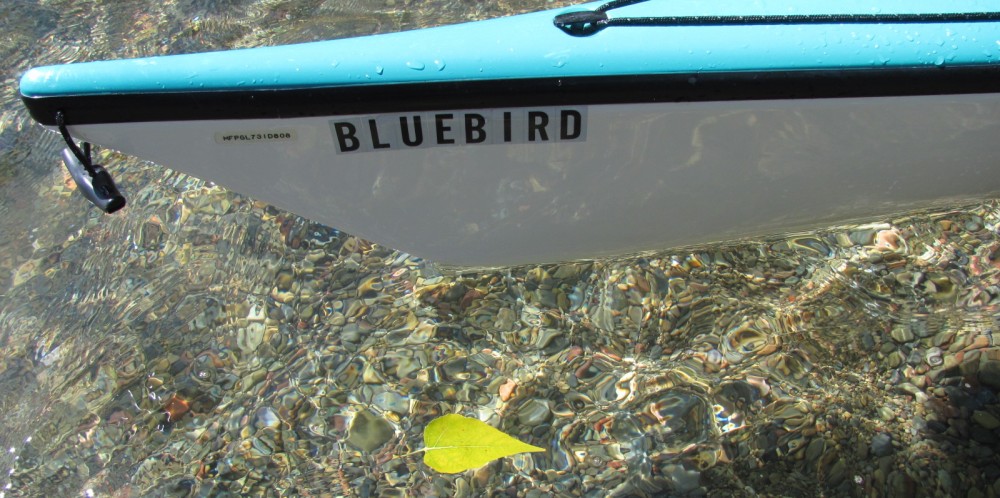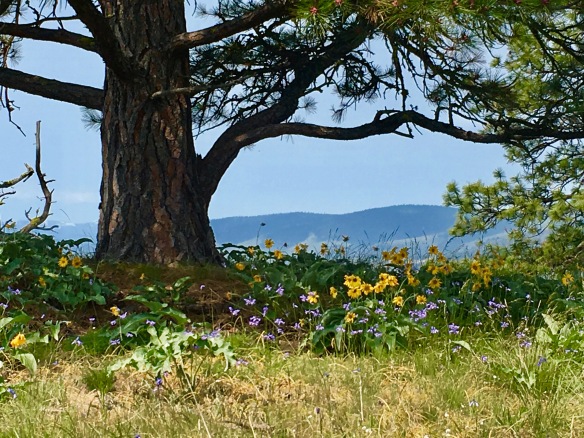Accident Under the Mother Tree
My mother died on May 26, 2007. At least we think that was the day. The nursing home lost track of her during the night. Grateful for her life, and the gift of my own, I try to go paddling each year around the time of her death day. I do this for several of reasons. Her generosity made it possible for me to buy my Current Designs Gulfstream, the kayak I use on Flathead Lake. The end of May is a nearly ideal time to paddle out to Wild Horse Island and explore its interior. Unless the weather has been unusually hot and dry many of the wildflowers are still blooming and I enjoy searching for the island’s wildlife. Paddling in May is also a way of giving thanks for my relatively good health and stamina, qualities my mother never enjoyed.
On May 29, I slipped through the morning’s commuter traffic, headed west on the interstate, and took the slow lane up the Evaro hill. To the east the meadows were full of snowmelt and wild iris. At Ninepipes the ponds were overflowing as the first truly warm days brought snow down off the Missions. To the west a heron stilted after fish in the grassy shallows. At the base of the Polson moraine I looked at the log decks at Hunt’s Timbers, bunks of material ready for sale, and thought about a friend’s request that I make her grave marker from pine purchased at Hunt’s. Near the bridge in Polson several boats of fishermen had lines in the water. At the Walstad fishing access the parking lot was empty.
Trusting the Graphical Forecast of “variable winds and waves less than a foot,” I pushed the wind around the north side of Melita Island, rounded the southeast corner of Wild Horse and headed up to Osprey Cove, one of many places on the lake where osprey and bald eagles compete with one another for territory and fish. I spotted one of each, breasts to the morning sun. Knowing that the lake is filling toward full pool, I lifted Bluebird onto one of the gravel benches parallel to the beach, peeled off my dry suit, and dug out my lunch sack and water bottle. On a previous trip I had begun exploring the steep draw that empties into the cove. This time I had time to climb it to the top. In the lower elevations Arrowleaf Balsamroot had finished blooming, but Arnica still caught my eye, along with a few spent Shooting stars, Larkspur and Harebells. In the deep shade of the forest a trio of bucks in velvet yanked at Balsamroot leaves.
As I continued to climb I realized that the draw would not end in a valley but in the island’s true summit. At the top I could see south to the islands of The Narrows, the Mission crest in the distance, west to the northern Bitterroot range still under snow.
Looking around for a good lunch spot, I noticed a “mother tree,” a large Ponderosa Pine. Beneath the drip line of the low branches Balsamroot and Harebells grew in a concentrated ring.
I backed in, rested against the trunk and opened my lunch sack. A little thirsty, I drank some of my water and ate half an apple. On these solo trips I often carry a can of sardines and my favorite Dakota bread from Great Harvest Bakery. Using my left hand to secure the tin I pulled the ring. At first the lid would not yield and the top developed a crown. It would take a lot more force now to peel back the lid. So, I set my shoulder to the task and pulled hard. When the lid finally gave way the edge of the tin sliced my left hand between thumb and index finger. Blood pulsed out of the open gash, spotted my clothes, lunch sack, and pine duff at my feet.
I knew I was in trouble and would need to make good decisions. I took time to breathe and think. I poured some of my water into the open wound, knowing that the sardine can was not sterile. Having left my first aid kit in the kayak down below, I had to find an alternative to compress and tape. I looked around for solutions and saw the big Balsamroot leaves. I broke off three, pressed them against the wound and then used a stem to bind everything in place.
Knowing that I still had to paddle roughly seven miles back to Walstad, I decided I’d better eat. So, I used the fingers of my right hand to pull the sardines out of the can, dividing the fish onto the two pieces of bread. I also took time to eat a Cliff bar and to consider my limited options.
Often traveling alone, I have developed a practice of noticing my surroundings when I hike. On the way down from the summit I looked again for the fallen pine whose roots now held a limestone block in the air, the snag with a nesting cavity, the patch of bare ground, a particular erratic boulder, the cliff dividing one side of the draw from the other, the fencing of an old corral. I did not want to end up in the wrong cove or waste energy looking for my boat. Once on the beach I plopped down on the edge of the water, let go of my bloody leaves, did a better job washing the wound and pulled out my first aid kit. Though not trained in making a dressing, I used a sterile gauze pad and two long strips of tape torn free with my teeth. Then it occurred to me that I could use my paddling glove (tucked in the hatch for emergencies), to create more pressure. I worked the tight black glove over the dressing and into place. Now I knew I could paddle.
Before slipping the boat back in the water I drank most of the contents of my spare bottle containing electrolytes called “Skraitch,” a less sweet alternative to drinks commonly used by athletes. I knew I would have difficulty pulling on my dry suit with its latex gaskets and long diagonal zipper, so I stowed the dry suit. I would have to trust the weather and smooth strokes. I did not want to roll in 43-degree water. In calm conditions I reversed my route but chose to paddle between Melita and homes along Labella Lane in case I needed help. As I rounded Melita I skirted a flock of ring-billed gulls clustered together on the gravel bar. After they scattered I noticed an eagle wing feather waiting to be discovered by Boy Scouts who would soon arrive. A slight tail wind carried me back to my starting point.
More slowly this time, I carried all my gear back to the truck and made myself re-load and secure the kayak. Driving back into town I realized that I was having trouble concentrating. Intersections and crosswalks felt like a flood of data. I decided to ask for help. I vaguely remembered a sign pointing to a clinic at the top of the hill south of town. The Ridgecrest Clinic did not accept walk-in patients so they directed me back into town to the clinic near St. Joseph’s Hospital. As I walked back toward my truck someone tapped me on the shoulder. A kind woman said, “I heard you describe your injury. Don’t drive back into town. Walk across the street. Those people will take care of you.” Indeed they did. From the women at the front counter helping me with paper work to the woman who helped me pull off the bloody glove, from the physician who tested tendons to Karen Smith who stitched the severed artery and closed the wound I received the care I needed. The leathery leaves of Balsamroot were a temporary solution at best.
Driving home I turned off the radio so I could concentrate. Along the way I reflected on my day. Many would say I should not make these trips by myself; the risk is too great. But if I am going to paddle to the islands at this time of the year I will probably paddle alone. In the future, if I combine a paddle with a hike, I will stow a fanny pack containing my box of first aid supplies and will not leave the kayak without it. Having watched skilled hands dress a wound, I am going to add a few new supplies to my Pelican box.
I return astonished by how quickly a day can change. A fall on the ice, a snowboard accident, a car crash happens in an instant. I find this humbling. Accidents befall even those who are prepared. In the end I’m glad I stopped for lunch under the mother tree on a day I wanted to honor my own mother. More than flowers grow in a ring beneath its sheltering limbs.




Wonderful story, Gary! Too bad it’s not fiction. How scary. Hope your healing will be swift. I would still encourage your lone paddles. Just leave the sardines behind.
Thanks, Sally. About the sardines—that’s what Joyce said… G.
You are courageous with the ability to focus and process what is essential to get yourself back to a safe environment. It could have been panic situation otherwise. I love your story and hope to read more of your adventures w/o critical scenarios, of course.
Thank you for your very kind response. This was my first, and I hope, last accident. Most posts are lyrical and reflective. Also, I enjoyed your attention to the apple tree.